Groundhog Day in Paradise
2020 Pandemic – Day 339

The grandfather clock in the entry hall sounds Westminster chimes followed by six gongs. I roll over and sit up on the edge of the bed in the dark, scratch my head, and yawn. I turn on the light, stumble into the bathroom, and look in the mirror at an old guy. Mussed-up silver hair, puffy eyes, sagging jowls. He is my grandchildren’s Papaw, and he looks the part.
I take my blood pressure pill, shave, brush my teeth, floss, gargle, shower, towel off, and step on the scales. Up another pound. I heave a sigh.
I dress, go downstairs, and open a can of dog food. When I set the bowls on the floor, Zoey and P.D. jump around, whipping my shins with their ropey tails, happy out of their minds about the same meal I’ve fed them twice a day for a decade.
Cindy and I watch the Channel 7 morning news. Governor Newsom, his pale face smiling like it hurts, begs Californians to stay at home, then apologizes yet again for the photos that caught him dining indoors at a pricey restaurant with a dozen people, none of them masked. “I made a mistake,” he says, just before he extends California’s stay-at-home order into late January.

The news anchor reports that yesterday’s death toll in Los Angeles broke the previous one-day record. She cuts to a clip of Mayor Garcetti’s press conference, broadcast last night from his home where he is quarantined because his daughter tested positive. “Our hospitals are overrun,” the mayor says with tears in his eyes. I feel sorry for him. The lockdown isn’t helping, but he doesn’t know what else to do so he doubles down. “Cancel everything,” he tells us.
We finish breakfast. Cindy heads into the family room to work on her needlepointing project, a multicolored elephant for one of our grandsons.
I read the newspaper. A front page article describes chaos at an east-side hospital. With twelve patients in crisis mode, overhead speakers sound Code Blues continuously. Seven die within a six hour shift, two in a hallway because there was no ICU bed available. Another article says 442 people died state-wide yesterday, one every three and a half minutes. Hospital morgues are overflowing; funeral homes are turning away corpses. I toss the newspaper in the trash and try to purge its dark images from my thoughts.
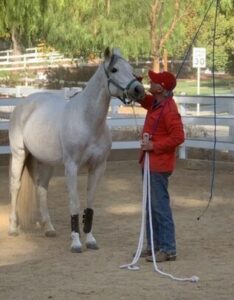
At eight, I put on my coat and boots for the main event of the day. “I’m leaving,” I shout to Cindy.
“Have a good time.”
I drive to the barn. When I come through the gate, Lily and Jackson nicker a greeting. I brush Lily’s mane and tail and groom her coat. My daughter and six-year-old granddaughter lead Marge into the corral from our other barn, tie her up, and tack up Jackson while I saddle Lily. The horse whisperer arrives on her gelding, Jesse. We’re masked and six feet apart as we mount up and ride out. My daughter leads on Jackson; I follow on Lily; the horse whisperer trails on Jesse, ponying Marge with my granddaughter up.
“Hey, Papaw, what’s the ghost’s favorite plant?” she says.
“I don’t know.”
“Bamboooo!”
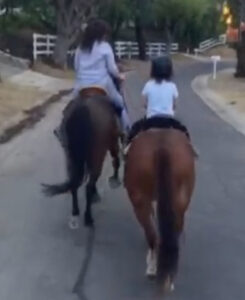
Our masks muffle our laughter.
It’s a beautiful day, clear sky, fifty degrees, the air crisp and clean. We crest a hill. Below us, the valley floor stretches out to purple mountains in the east. Later, on flatland, the horse whisperer schools my granddaughter on trotting. Her back is straight; her hands quiet; her form perfect. We end the ride with an easy walk down Long Valley Road to the barn.
When the others leave, I fetch carrots from the tack room and give one to Lily. She riffles my arm with her lips and rests her head on my shoulder. Jackson bangs around in the next stall, jealous. I give him a carrot, pet him, then drive back home.
Before the stay-at-home order I would meet my trainer at the gym for an hour’s workout three days a week. Now I exercise at home with weights and an athletic ball. Without the trainer’s encouragement I give up after thirty minutes.

Back in the house, Cindy shows me the morning’s handiwork. The vivid colors and intricate stitching on a flat canvass resemble an anaconda instead of an elephant, but when she converts her projects to three dimensions, they always magically transform into a stunning work of art.
After lunch, I sit in my home office and work on my novel. Jerry Dade is 73, a life-long bank robber who suffers from symptoms of dementia. He’s terrified, and I want to save him. All the main characters in my novels came through dark caves into the light, but I can’t seem to find a credible way out for Jerry.

After a couple hours of frustration, I take a break, drive to the other barn, and hang out with Marge and Wilson. Wilson’s a big old boy with a gentle disposition. Feeling bad that we left him behind today, I promise him I’ll ride him tomorrow. The break helps. I come up with an idea, go back home, and write it out.
You can set your watch by the dogs’ internal clocks. At four sharp they start dancing around my desk. There’s no denying them. I grab their leashes and drive them to a trail head. We walk less than a mile in an hour as they pause over every scent.

Back at home, the dogs’ evening meal produces another frenzied euphoria. Cindy and I grill chicken and make a salad. After dinner we watch television, then go to bed. Cindy falls asleep while I read. I’m in the middle of Paris Trout by Pete Dexter. When the page blurs, I turn off the bedside lamp. I brood about the spread of Covid and the stay-at-home order as I drift off to sleep.
Day 340
 The grandfather clock in the entry hall sounds Westminster chimes followed by six gongs. I roll over and sit up on the edge of the bed in the dark, scratch my head, and yawn. I turn on the light, stumble into the bathroom, and look in the mirror at an old guy.
The grandfather clock in the entry hall sounds Westminster chimes followed by six gongs. I roll over and sit up on the edge of the bed in the dark, scratch my head, and yawn. I turn on the light, stumble into the bathroom, and look in the mirror at an old guy.
Later, standing at the kitchen counter, I’m opening a can of dog food when a description of a medical crisis in yesterday’s newspaper comes back to haunt me. A hospital bed in an ICU. An endotracheal tube extends from a patient’s mouth to a gasket connected to a ventilator. Exhausted health care workers in hazmat suits hover over him. His eyes widen with panic. He gasps for breath.
As I look out the window at the amber glow of another picturesque sunrise at the top of another perfect day a sense of guilt washes over me. I’m quarantined in a Garden of Eden with Cindy, the horses, and the dogs. As long as I keep my distance, I can still see my children and grandchildren. The rate of infection in Hidden Hills is among the lowest in the county, but in the unlikely event the virus finds us here, Cindy and I are healthy and we’ll beat it. I’ve got it made, but while others struggle just to survive, I sulk about being locked down in Paradise. My malaise is selfish and frivolous, and I’m ashamed of it.
“You’d better feed them before they break your legs,” Cindy says, standing beside me.
I come out of my trance to the sting of ropey dog tails lashing my shins. I set the bowls on the floor, and Zoey and P.D. gobble up their standard chow like it’s filet mignon. Cindy smiles. I do, too.
In bed that night, I read Paris Trout. The page blurs. I turn off the light. The day has followed the pattern of all the previous days of the stay-at-home order, but this time as I drift off to sleep, instead of worrying about Covid, I think about Cindy’s smile, Lily’s soulful eyes, and my granddaughter riding Marge.
Post Script: Apparently, my sense of guilt is not unique. See The Paradox of Privilege: Guilt During Covid-19 at https://www.orfonline.org/expert-speak/the-paradox-of-privilege-guilt-during-covid19-65509/





 The original concept was that I would write about the craft of creating a novel, but I soon discovered I don’t have much to offer on that subject. My “process” is maddeningly chaotic. I write a huge volume of unpublishable blather, cull out the few coherent passages, revise them endlessly, and throw away most of the rewrites. When I’m on the verge of jumping off a tall building in frustration, a story sometimes steps out of the fog of confusion and grabs me by the throat and the writing begins to flow. I don’t understand it; I wouldn’t wish it on anyone; and I sure as hell don’t want to write about it.
The original concept was that I would write about the craft of creating a novel, but I soon discovered I don’t have much to offer on that subject. My “process” is maddeningly chaotic. I write a huge volume of unpublishable blather, cull out the few coherent passages, revise them endlessly, and throw away most of the rewrites. When I’m on the verge of jumping off a tall building in frustration, a story sometimes steps out of the fog of confusion and grabs me by the throat and the writing begins to flow. I don’t understand it; I wouldn’t wish it on anyone; and I sure as hell don’t want to write about it.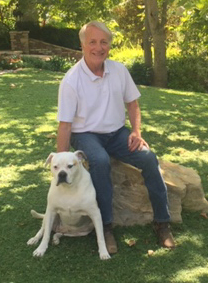 Meanwhile, Bobbye made it easy to publish my stories. She set up my website in its current form and maintains it. She rides herd on the weird dudes in London, who fight off the Russian bots, spam jockeys, and ubiquitous hackers determined to saddle my posts with links to porn, payday loans, bitcoin traders, Viagra vendors, phony casinos, a young woman named Kristina who’s searching for a sugar daddy, and a host of other scam artists. She proofreads the Word document I send her every month for typos and content, synthesizes it with photos, and creates the presentation you find on my website’s blog page. She prepares the format and promotional pitches for my newsletter, maintains its mailing list, distributes it, and forwards all the readers’ comments to me. I’m technologically incompetent, so when I do something that fouls up the entire website, she somehow straightens it out, creating order out of rampant chaos.
Meanwhile, Bobbye made it easy to publish my stories. She set up my website in its current form and maintains it. She rides herd on the weird dudes in London, who fight off the Russian bots, spam jockeys, and ubiquitous hackers determined to saddle my posts with links to porn, payday loans, bitcoin traders, Viagra vendors, phony casinos, a young woman named Kristina who’s searching for a sugar daddy, and a host of other scam artists. She proofreads the Word document I send her every month for typos and content, synthesizes it with photos, and creates the presentation you find on my website’s blog page. She prepares the format and promotional pitches for my newsletter, maintains its mailing list, distributes it, and forwards all the readers’ comments to me. I’m technologically incompetent, so when I do something that fouls up the entire website, she somehow straightens it out, creating order out of rampant chaos.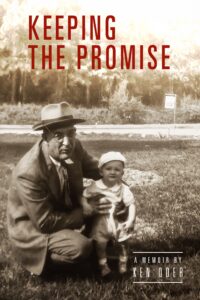 Keeping the Promise is the result of our partnership, a collection of my first fifty blog posts, a series of non-fiction short stories in the nature of an episodic memoir presented out of chronological order and grouped under the headings Milestones, Interesting People I’ve Met Along the Way, Growth From Adversity, Murder Most Foul, Faithful Companions, and On Writing. The book’s title is taken from a post about my grandfather published in May 2020, in the early days of the current pandemic. A short time before he passed away, he asked me to promise him I’d always try hard at everything I did. I made the promise, although I wasn’t sure I would keep it, and I haven’t always lived up to it in the fifty years that followed. These posts recall events on both sides of that ledger. The blog post,
Keeping the Promise is the result of our partnership, a collection of my first fifty blog posts, a series of non-fiction short stories in the nature of an episodic memoir presented out of chronological order and grouped under the headings Milestones, Interesting People I’ve Met Along the Way, Growth From Adversity, Murder Most Foul, Faithful Companions, and On Writing. The book’s title is taken from a post about my grandfather published in May 2020, in the early days of the current pandemic. A short time before he passed away, he asked me to promise him I’d always try hard at everything I did. I made the promise, although I wasn’t sure I would keep it, and I haven’t always lived up to it in the fifty years that followed. These posts recall events on both sides of that ledger. The blog post, 


 The pukey contest in 2016 was the national Presidential election. Hillary Clinton and Donald Trump ran relentlessly negative campaigns with her basket of deplorables and his rally chants of “Lock her up.” I felt like a rat poised at the head of a T‑shaped Skinner Box with both metal bars at opposite ends of the T set to deliver a high voltage shock no matter which lever I pulled.
The pukey contest in 2016 was the national Presidential election. Hillary Clinton and Donald Trump ran relentlessly negative campaigns with her basket of deplorables and his rally chants of “Lock her up.” I felt like a rat poised at the head of a T‑shaped Skinner Box with both metal bars at opposite ends of the T set to deliver a high voltage shock no matter which lever I pulled. In a desperate attempt to increase their voter turnout, the small band of remaining California Republicans created their own ballot boxes, labeled them “Official,” and placed them in strategic locations across the state. The Democrats went ballistic. The state Attorney General, Xavier Becerra, a Democrat, launched an investigation.
In a desperate attempt to increase their voter turnout, the small band of remaining California Republicans created their own ballot boxes, labeled them “Official,” and placed them in strategic locations across the state. The Democrats went ballistic. The state Attorney General, Xavier Becerra, a Democrat, launched an investigation.
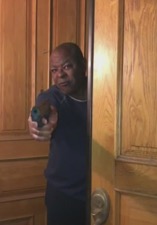

 I haven’t thrown up yet, but it’s not over. With the uncertainties of the process and both presidential campaigns gearing up for legal challenges, I’ll be chugging Pepto Bismol all the way to Inauguration Day.
I haven’t thrown up yet, but it’s not over. With the uncertainties of the process and both presidential campaigns gearing up for legal challenges, I’ll be chugging Pepto Bismol all the way to Inauguration Day.